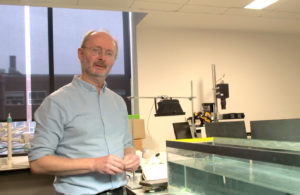The ideas behind the videos of foam rubber in water tanks, intended to illustrate features such as isostasy and flexure, were stimulated during my planning for a talk in a Herdman Society Symposium, possibly around 1995. I knew that I would have a broad audience and at the time was working on how deeply buried rocks (eclogites) were returned to the surface. I wanted to explain the importance of buoyancy but without describing it in mathematical terms. I realised that bodies of water would provide a playground to illustrate relevant ideas simply. First I approached Liverpool University Sub-Aqua Club and suggested they do something with lilos in the Sports Centre swimming pool. For unfathomable reasons this idea was not received with enthusiasm. So then I settled upon taking photographs of foam rubber in water tanks. I used an ornamental hollow wooden duck to illustrate basic isostasy, which led to some frivolity, though it – like other objects – reaches isostatic equilibrium perfectly well. It’s illustrated in my 2002 ESTA article.
The 2019 videos show me playing with the foam rubber and so forth, and I am fully aware that these demonstrations are not precisely analogous to Earth behaviour, even if they were to be scaled. But I will tell you one thing: when you actually undertake the demonstrations, you FEEL the buoyancy forces, especially when holding down a subducted continental plate. It’s real. The new angle we introduced in the videos was to simulate the melting of an ice sheet by – well – melting an ice sheet. When I saw the speeded up video of the sheet melting, I realised that (for some unanticipated reason) one side melted faster than the other and consequently the whole system tilted, since the weight disappeared faster on one side than the other. I then fell to wondering whether that is what continental plates have done during ice ages. Such is the value of analogue experiments.
The idea was published in the ESTA journal. When I have a bit of time, I will provide a narrative to give more detail on how the video clips illuminate actual Earth behaviour.



Leave a Reply